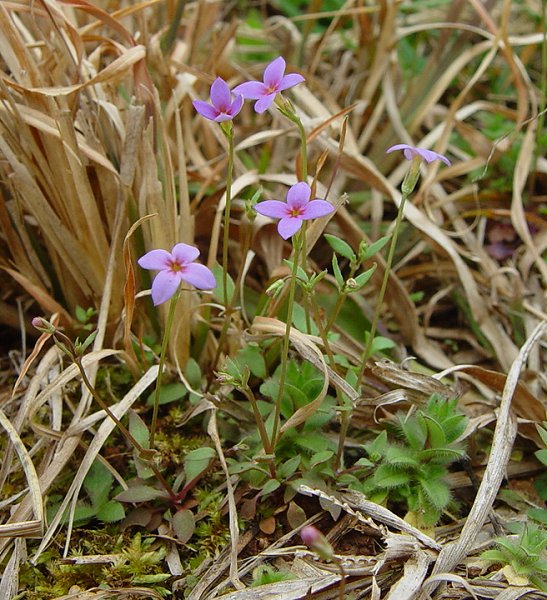Houstonia pusilla Schpf
Small Bluets

Native
CC = 3
CW = 3
MOC = 75
© DETenaglia
Houstonia pusilla SchpfSmall Bluets | |
 |
Native CC = 3 CW = 3 MOC = 75 |
© DETenaglia |
|
Family - Rubiaceae Habit - Annual forb from a weak taproot.
Stems - Ascending to erect, to 12 cm, sometimes multiple from base, glabrous. Leaves - Opposite, simple, entire. Basal rosette not formed, but lower nodes sometimes crowded. Stipules 0.8-1.5 mm long, triangular, broadly to narrowly pointed at the tip, entire along the margins. Leaf blades 4-11 mm long, 1-4 mm wide, elliptic to oblanceolate, broadly to narrowly pointed at the tip, angled or tapered at the base, the margins entire and generally flat, sometimes minutely hairy, the surfaces glabrous or minutely hairy, without visible venation. Lowest leaves petiolate, the petioles to 6 mm, glabrous. Upper leaves nearly sessile, thinner than those near the base of the plant.
Inflorescence - Single flowers terminating long axillary peduncles. Peduncles to 3.5 cm long. Flowers - Homostylous. Calyx lobes 4, 1-4 mm long, sometimes slightly unequal, 1/2 as long to slightly longer than the adjacent corolla tube, triangular. Corollas trumpet-shaped, sky blue to lavender or violet, occasionally pink or white, usually with a contrasting reddish ring at the top of the throat, externally glabrous, internally pubescent in the upper part of the tube, the tube 2-5 mm long, the 4 lobes 2.0-5.5 mm long, lanceolate. Stamens 4, alternating with the corolla lobes, included. Filaments essentially absent. Anthers yellow, ovoid, 1 mm long. Style green, glabrous, 1.1 mm long. Stigma thicker than style and giving the pair a clavate appearance. Ovary inferior, surrounded by the calyx tube.
Fruits - Capsules 1.5-3.0 mm long, 2.5-5.0 mm wide, subglobose to depressed-obovoid, somewhat flattened laterally, partially inferior, sometimes slightly 2-lobed, glabrous or nearly so. Seeds 0.5-1.0 mm long.
Flowering - March - April. Habitat - Glades, woodland seeps, river margins, meadows, lawns, pastures. Origin - Native to the U.S. Lookalikes - Houstonia caerulea. Other info. - This little species can be found across most of Missouri with the possible exception of the northwest corner. It is also found in most of the southeastern continental U.S. Under optimal conditions it can be very abundant, causing waves of lavender haze across lawns and roadsides. It can be confused with another small bluet, H. caerulea, but that species has powder-blue corollas with a yellow eye at the throat. The plant is quite striking for its small size and would be a worthy candidate for cultivation in a rock garden. Photographs taken in Vale, NC., 3-15-03 (DETenaglia); also at Daniel Boone Conservation Area, Warren County, MO, 3-1-2012, Don Robinson State Park, Jefferson County, MO, 4-26-2019, and near Labadie, Franklin County, MO, 3-6-2020 (SRTurner). |